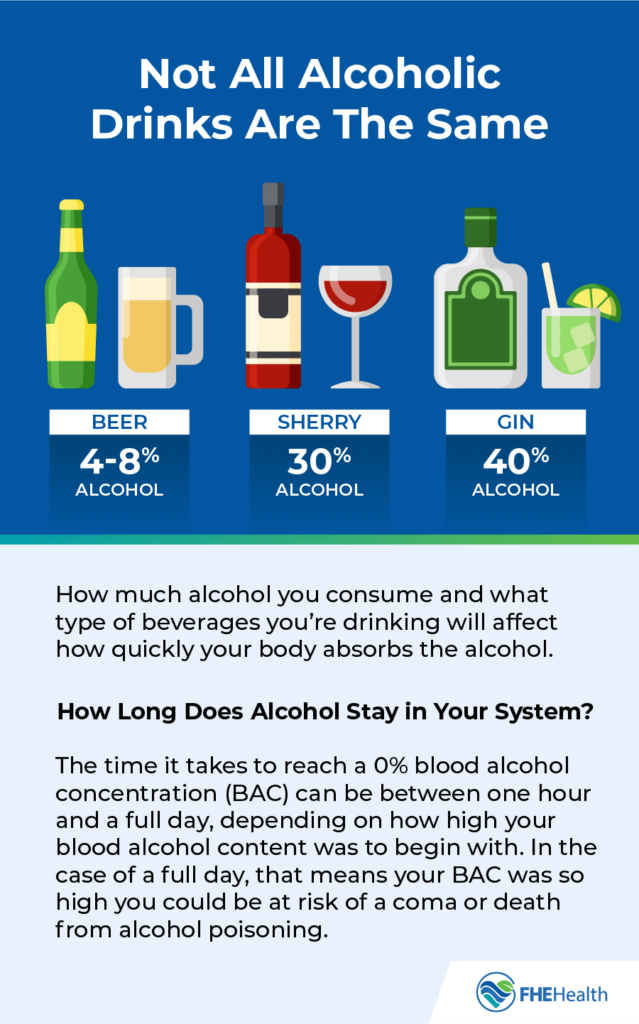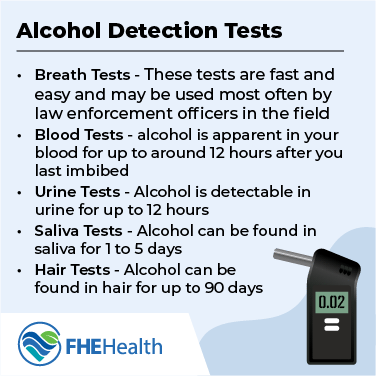Whether or not someone has consumed alcohol recently can be determined with a variety of lab tests such as tests on breath, saliva, urine, hair or blood. How long alcohol is detectable in your system depends on a number of factors, including the type of test being used. Find out more about the alcohol detection window and why you might find yourself dealing with such tests below.
How Long Does Alcohol Stay in Your System?
How quickly your body absorbs alcohol depends on factors that include your weight and health, how much alcohol you consume and what type of beverages you’re drinking. Not all alcoholic drinks are the same; beer has an average alcohol concentration of around 3 to 8%, while sherry has a concentration as high as 30%, and some liquors reach up to 40% on average.
Plus, the other ingredients in your drink also play a role. Carbonated beverages, such as champagne or a whiskey mixed with soda, are absorbed faster. But the rate at which alcohol leaves your body depends heavily on your liver. On average, a healthy liver processes 0.016% BAC per hour. The time it takes to reach a 0% blood alcohol concentration (BAC) can be between one hour and a full day, depending on how high your blood alcohol content was to begin with. In the case of a full day, that means your BAC was so high you could be at risk of a coma or death from alcohol poisoning.
Typically, a blood alcohol content, or BAC, test is only accurate within six to 12 hours after someone has had their last drink when determining whether someone was legally intoxicated. However, the biomarkers — or physical evidence — that you consumed alcohol can be present for days or even weeks and are detectable by other specialty tests.

When and Why Is the Presence of Alcohol Tested?
When someone talks about drug tests, many people automatically think of random employer drug testing. Since alcohol consumption among adults is not illegal, most employers aren’t going to test randomly to see if their workers have consumed alcohol in the recent past. Here are some times and reasons you might face a test for alcohol consumption.
- A law enforcement officer has reason to believe you were driving under the influence and requests that you take a breathalyzer or blood alcohol test.
- You work for an employer that chooses to or is required to test for alcohol use because of safety concerns, such as employers hiring for positions that fall under the Department of Transportation’s safety-sensitive definitions.
- Your employer has required you to agree to random alcohol use tests because of a previous issue of being intoxicated on the job.
- You are part of a rehab program or treatment plan that requires you to submit to periodic tests for alcohol use.
- You are being considered for an organ transplant — specifically a liver transplant — and medical staff must ensure you haven’t been drinking alcohol.
- You are part of a legal or criminal investigation, and whether or not you had any alcohol within a certain time frame is of material fact.
Alcohol Detection Window and Specific Types of Tests
 Alcohol can be detected in your body in five main ways, and the type of test used depends on the situation.
Alcohol can be detected in your body in five main ways, and the type of test used depends on the situation.
Alcohol Detection Window for Breath Tests
Breath tests are fast and typically easy when the right equipment, such as a Breathalyzer, is on hand. For this reason, these tests may be used most often by law enforcement officers in the field, employers who have a regular need to check that people are not using alcohol on the job or counselors and others who are using alcohol tests as part of a structured rehab program.
Alcohol can be detected on your breath for up to 24 hours from the time you last drank.
Testing Your Alcohol Blood Level
Testing your blood for evidence of alcohol requires drawing the blood and testing it, typically in a lab. Usually, alcohol is apparent in your blood for up to around 12 hours after you last imbibed.
Generally, a blood test is only used to determine the scale of alcohol content — to what level a person is intoxicated at a specific time — to find out whether someone meets legal limits for being drunk. Blood tests aren’t usually used to simply test that alcohol was consumed. Due to the shorter window of time and availability of other detection methods, blood is generally not used to detect alcohol. Even post-mortem blood alcohol tests are not always reliable due to potential fermentation and infection.
Alcohol Detection Window for Urine, Saliva and Hair Tests
Many people ask, “How long does alcohol stay in urine?” Alcohol itself is typically detectable in the urine for up to around 12 hours. But the by-products of alcohol consumption can be found in urine for much longer. Ethyl glucuronide, or EtG, which is a biological by-product that occurs when you consume alcohol, has been shown to be detectable up to two days after any drinking and up to five days following a heavy drinking session.
Many ‘panel’ cups contain testing strips for both Alcohol and EtG. This is crucial in testing as there is a shorter detection window for these compounds. The test strips in the cup will signal the detection of these compounds regardless of whether the sample is tested in a confirmation panel at a lab within the window.
Biological markers, including EtG, can also be measured through tests performed on hair and saliva. Alcohol or evidence of alcohol consumption can be found in saliva for one to five days, but it can be found in hair for up to 90 days under some conditions. Even given the longevity of alcohol markers in the hair, urine remains the more popular method of testing in medical, rehab and employment environments.
Can You Alter the Results of an Alcohol Test?
There’s a difference between a blood alcohol content test, which measures how much alcohol is in your system, and a test designed simply to determine if there was alcohol in your system. BAC tests can be unreliable if they aren’t performed correctly, and many people attempt to influence the test by trying to delay or contaminate it.
Tests that look for biological markers of alcohol use are more reliable, but people do still try to cheat them. For example, some people try to get someone else to give the urine sample, if that’s possible, given the scenario. In most cases, when an alcohol test is required, the testing organization, employer or law enforcement unit has a procedure in place to keep this type of thing from occurring.
There are many myths and tips for beating a breathalyzer, but most are fiction. Attempting to use mints or mouthwash may cover up the smell, but do not actually change the amount of alcohol you exhale. The myth of ‘sucking on a penny’ or keeping one under your tongue also does not hold any truth. A well-conducted test rarely leaves room for manipulation.
Getting Help for Alcohol Addiction Today
If you’re in a situation where an alcohol test is being administered — or is going to be administered — and you’re wondering how long alcohol stays in your system, it might be time to consider whether you need to reach out for help with a substance abuse disorder. If it’s so critical that you don’t drink that you would make a specific effort to alter a test that showed you did, then you might be dealing with an addiction. Contact FHE Health today to find out how our treatment programs can help you break out of the cycle of addiction and live a sober life free of alcohol.








